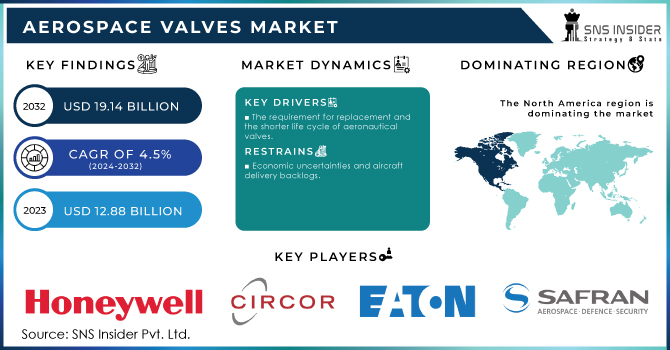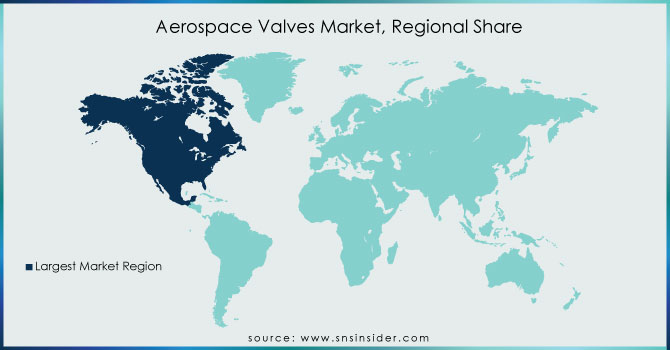Aerospace Valves Market Report Scope & Overview:

To get more information on Aerospace Valves Market - Request Free Sample Report
The Aerospace Valves Market Size was valued at USD 12.88 billion in 2023 and is expected to reach USD 19.14 billion by 2032 with a growing CAGR of 4.5% over the forecast period 2024-2032.
An aerospace valve is a device that closes, partially obstructs or opens passageways to guide, regulate, or control the flow of fluids such as gases, fluidized solids, liquids, or slurries. Valves are fittings; however, they are typically classified as a separate category. Aerospace valves play a significant part in hydraulic action points, which are critical to any aircraft operation. As a result, the aerospace valve must be precise and durable to improve the aircraft's performance.
Heat management, managing oil and fuel directional flow, enabling anti-icing, maintaining pressure control, and optimizing temperature limits are all functions performed by aerospace valves, which are part of the motion and flow control technologies. Advancements are being made in the development of aeronautical valves. Electronically controlled aerospace valves are increasingly being used to reliably and effectively manage the flow of gas or liquid and mechanical movements across numerous places aboard airplanes.
MARKET DYNAMICS
KEY DRIVERS
-
Globally, aviation passenger traffic is increasing.
-
The requirement for replacement and the shorter life cycle of aeronautical valves.
RESTRAINTS
-
Economic uncertainties and aircraft delivery backlogs
-
changing pricing of raw materials used in valve manufacturing
OPPORTUNITY
-
Aerospace valve manufacturers can benefit from the Internet of Things.
-
Analytical systems are becoming more technologically advanced.
CHALLENGES
-
Failure of valves, such as the fuel crossfeed valve on the Airbus not opening.
-
build high-quality valves and properly integrate them into aviation systems.
IMPACT OF COVID-19
Eaton Corporation PLC, Safran, Woodward, Inc., Triumph Group, and Parker Hannifin Corporation is among the leading participants in the aerospace valves industry. These companies have expanded their operations in North America, Europe, Asia Pacific, the Middle East, Africa, and Latin America. COVID-19 has also influenced their enterprises. COVID-19, according to industry insiders, will have an impact on aircraft valve manufacture and services internationally in 2020. The COVID-19 pandemic has hurt end-use sectors, resulting in a sharp drop in 2020 aircraft sales and deliveries. In the medium term, this is projected to hurt the aerospace valves market, with a modest recovery predicted in the First Quarter of 2021.
The market for environmental control systems is likely to be the most valuable. By value, the environment control segment is predicted to be the largest. The numerous sub-systems that make up the environment control system sector of the aerospace valves market, including air supply, temperature management, cabin pressurization, avionics cooling, smoke detection, and fire suppression, have contributed to the industry's expansion. Other essential systems that employ aerospace valves include the pneumatic, hydraulic, and fuel systems. Aerospace valves in the lubrication system keep oil pressure under control, while valves in the water and wastewater system allow potable water to flow to the water distribution system, which is subsequently utilized by passengers and personnel onboard.
The Butterfly Valves segment of the aerospace valves market is expected to grow at the fastest rate during the forecast period. The Butterfly Valves section of the aerospace valves market is growing due to its widespread use in a variety of applications due to its small size, low space requirements, and ease of use. These are often found in aviation fuel and pneumatic systems. In the aerospace valves market, the stainless-steel segment is expected to have the biggest revenue share based on material The widespread usage of stainless steel in aircraft valve manufacture may be ascribed to its qualities and advantages, which include ease of availability, cheap cost, heat resistance, and high strength. It's employed in applications with a high risk of corrosion and a high operating temperature.
The fixed-wing aircraft sector is expected to have the greatest revenue in the aerospace valves market during the forecast period, based on aircraft type. Commercial aviation, business, general aviation, and military aviation make up the fixed-wing aircraft category. In terms of absolute numbers, the fixed-wing sector has the largest number of aircraft. However, the aerospace valves market is expected to grow at the fastest rate in the Unmanned Aerial Vehicles category.
KEY MARKET SEGMENTATION
By Type
-
Butterfly Valves
-
Rotary Valves
-
Solenoid Valves
-
Flapper-nozzle Valves
-
Poppet Valves
-
Gate Valves
-
Ball Valves
-
Others
By Application
-
Fuel System
-
Hydraulic System
-
Environmental Control System
-
Pneumatic System
-
Lubrication System
-
Water & Wastewater System
By Material
-
Stainless Steel
-
Titanium
-
Aluminum
-
Others
By Aircraft Type
-
Fixed Wing
-
Rotary wing
-
Unmanned Aerial Vehicles
By End-Use
-
OEM
-
Aftermarket
REGIONAL ANALYSIS
Geographically, North America continues to dominate the market, and this position will be maintained during the projection period. From component manufacture to aircraft assembly to military and security leadership, the region is underpinned by strong industry intelligence, making it a center of the aircraft industry. In the area, there is also a rising demand for lightweight, high-performance aerospace valves to meet the demands of contemporary aircraft platforms.
During the forecast period, Asia Pacific will have the highest CAGR in the global market, owing to the region's growing interest in indigenous component and system manufacturing, low labor costs attracting aircraft industry stakeholders from developed economies, and the largest fleet size of commercial aircraft ensuring substantial market demand.

Need any customization research on Aerospace Valves Market - Enquiry Now
REGIONAL COVERAGE:
-
North America
-
USA
-
Canada
-
Mexico
-
-
Europe
-
Germany
-
UK
-
France
-
Italy
-
Spain
-
The Netherlands
-
Rest of Europe
-
-
Asia-Pacific
-
Japan
-
South Korea
-
China
-
India
-
Australia
-
Rest of Asia-Pacific
-
-
The Middle East & Africa
-
Israel
-
UAE
-
South Africa
-
Rest of Middle East & Africa
-
-
Latin America
-
Brazil
-
Argentina
-
Rest of Latin America
-
KEY PLAYERS
The major Players are Honeywell International Inc, CIRCOR International, Inc., Parker Hannifin Corporation, Safran, Moog Inc., Aero Fluid Products, Sitec Aerospace GmbH, Meggitt PLC, Crissair Inc, Eaton Corporation Inc. and Other Players
| Report Attributes | Details |
|---|---|
| Market Size in 2023 | US$ 12.88 Billion |
| Market Size by 2032 | US$ 19.14 Billion |
| CAGR | CAGR of 4.5% From 2024 to 2032 |
| Base Year | 2023 |
| Forecast Period | 2024-2032 |
| Historical Data | 2020-2022 |
| Report Scope & Coverage | Market Size, Segments Analysis, Competitive Landscape, Regional Analysis, DROC & SWOT Analysis, Forecast Outlook |
| Key Segments | • By Type (Butterfly Valves, Rotary Valves, Solenoid Valves, Flapper-nozzle Valves, Poppet Valves, Gate Valves, Ball Valves, Others) • By Application (Fuel System, Hydraulic System, Environmental Control System, Pneumatic System, Lubrication System, Water & Wastewater System) • By Material (Stainless Steel, Titanium, Aluminum, Others) • By Aircraft Type (Fixed Wing, Rotary wing, Unmanned Aerial Vehicles) • By End-Use (OEM, Aftermarket) |
| Regional Analysis/Coverage | North America (USA, Canada, Mexico), Europe (Germany, UK, France, Italy, Spain, Netherlands, Rest of Europe), Asia-Pacific (Japan, South Korea, China, India, Australia, Rest of Asia-Pacific), The Middle East & Africa (Israel, UAE, South Africa, Rest of Middle East & Africa), Latin America (Brazil, Argentina, Rest of Latin America) |
| Company Profiles | Honeywell International Inc, CIRCOR International, Inc., Parker Hannifin Corporation, Safran, Moog Inc., Aero Fluid Products, Sitec Aerospace GmbH, Meggitt PLC, Crissair Inc, Eaton Corporation Inc. |
| DRIVERS | • Globally, aviation passenger traffic is increasing. • The requirement for replacement and the shorter life cycle of aeronautical valves. |
| RESTRAINTS | • Economic uncertainties and aircraft delivery backlogs • changing pricing of raw materials used in valve manufacturing |

